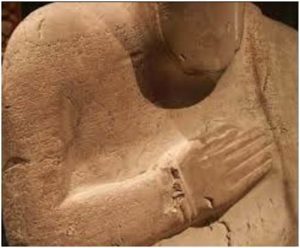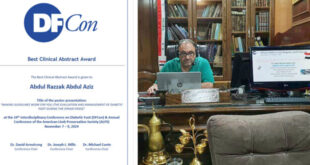Damascus, SANA – Archaeological mural inscriptions and paintings in Syria bear witness to an ancient culture and one of the oldest civilizations interested in historiography and historic documentation preceded by the Greeks and Romans.
“Syria is home to the oldest mural painting in the world which depicts the crowning ceremony of Idrimi, the king of Alalakh. It was unearthed in the Kingdom of Mari (Tal al-Hariri now) in 1939. The autobiographical inscription found on the Statue of Idrimi’s base archives the King’s vicissitudes and major events in his life (his rise to power and military achievements),” said Mahmoud al-Sayyed, a historiographer and an expert in ancient languages and inscriptions at the General Directorate of Antiquities and Museums.
He added that Idrimi was a Canaanite king who ruled the kingdom of Mukish, northwest Syria, with Alalakh city as its vassal between 1490 -1500 or 1450 -1475 B.C. The Statue of Idrimi was found broken and buried in a room in the annex of a temple from the latest level of Alalakhfollowing the city’s destruction around 1200 B.C. It is carved of hard white dolomitic magnesite and the eyebrows, eyelids and pupils are inlaid with glass and black stone. The king, who is seated on a throne made of basalt, wears a round-topped crown with band and neck-guard and a garment with narrow borders.
A text that is written in Akkadian language in cuneiform script covered the front of the Statue and the edge of the right cheek running down the side of the beard. In 104 lines, the inscription narrates the autobiography of a famous king in the Ancient Orient, his achievements and misfortunes. The adventure story of King Idrimi who flees with the royal family from Aleppo to Emar kingdom (Maskaneh now) on the Euphrates River when his father is murdered. Upon his return, Idrimi re-establishes his rule and extends it from Syrian Coast to Aleppo and from Kizzuwatna to Ugarit kingdom, including al-Ghab Plain. He records his building activities in Alalakh, including a palace that is probably to be identified with the structure of thirty-three rooms found on the site. Idrimi reigns 30 years before causing the inscription to be written and passing rulership to his son.
Idrimi inscription provided a useful source that helps document historic events, the geographical borders and political relationships prevailed between kingdoms in northern Syria at that time, said al-Sayyed, adding that it also enabled understand the nature and reasons of political and military conflict between the Mitannian kingdom and the Hittite Empire.
Furthermore, the first mural painting was discovered among the ruins of an 11,000-year-old house at Tal Jaadet al-Maghra archeological site on the left bank of the Euphrates river, northern Syria. It dates back to the Neolithic Era ( the New Stone Age). While the oldest mural painting was found in the kingdom of Mari. The painting which belongs to the Middle Bronze Age depicted the famous investiture of Zimri-Lim, a scene shows King Zimri-Lim of Mari receiving the symbols of rule from goddess Ishtar.
To conclude, historians and researchers traced the development of cuneiform writing back through its various stages to a system of accounting associated with the beginnings of agriculture as demonstrated in Syria 8000 BC. The earliest example of alphabetic writing was a clay tablet with 32 cuneiform letters found in Ugarit in Syria and dated to 1450 B.C., according to the Guinness Book of Records, not to mention the cuneiform tablets unearthed in Tal Mardikh which yielded written documentation of Ebla Kingdom. And thus,Syria can be considered as a cradle of one of the earliest known human civilizations.
R. Raslan / Ghossoun
 Syrian Arab News Agency S A N A
Syrian Arab News Agency S A N A


